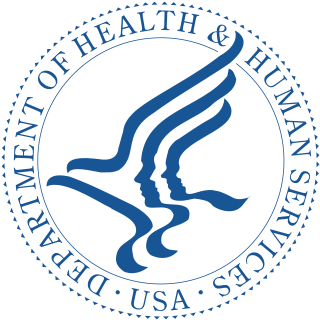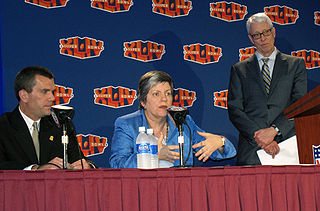Homeland security is an American national security term for "the national effort to ensure a homeland that is safe, secure, and resilient against terrorism and other hazards where American interests, aspirations, and ways of life can thrive" to the "national effort to prevent terrorist attacks within the United States, reduce the vulnerability of the U.S. to terrorism, and minimize the damage from attacks that do occur." According to an official work published by the Congressional Research Service in 2013, the "Homeland security" term's definition has varied over time.

The United States Department of Homeland Security (DHS) is the U.S. federal executive department responsible for public security, roughly comparable to the interior or home ministries of other countries. Its stated missions involve anti-terrorism, border security, immigration and customs, cyber security, and disaster prevention and management.

The United States Department of Health and Human Services (HHS) is a cabinet-level executive branch department of the U.S. federal government created to protect the health of the U.S. people and providing essential human services. Its motto is "Improving the health, safety, and well-being of America". Before the separate federal Department of Education was created in 1979, it was called the Department of Health, Education, and Welfare (HEW).

The Federal Emergency Management Agency (FEMA) is an agency of the United States Department of Homeland Security (DHS), initially created under President Jimmy Carter by Presidential Reorganization Plan No. 3 of 1978 and implemented by two Executive Orders on April 1, 1979. The agency's primary purpose is to coordinate the response to a disaster that has occurred in the United States and that overwhelms the resources of local and state authorities. The governor of the state in which the disaster occurs must declare a state of emergency and formally request from the President that FEMA and the federal government respond to the disaster. The only exception to the state's gubernatorial declaration requirement occurs when an emergency or disaster takes place on federal property or to a federal asset—for example, the 1995 bombing of the Alfred P. Murrah Federal Building in Oklahoma City, Oklahoma, or the Space Shuttle Columbia in the 2003 return-flight disaster.

The United States secretary of homeland security is the head of the United States Department of Homeland Security, the federal department tasked with ensuring public safety in the United States. The secretary is a member of the Cabinet of the United States. The position was created by the Homeland Security Act following the attacks of September 11, 2001.

A National Special Security Event (NSSE) is an event of national or international significance deemed by the United States Department of Homeland Security (DHS) to be a potential target for terrorism or other criminal activity. These events have included summits of world leaders, meetings of international organizations, presidential nominating conventions and presidential inaugurations. NSSE designation requires federal agencies to provide full cooperation and support to ensure the safety and security of those participating in or otherwise attending the event, and the community within which the event takes place, and is typically limited to specific event sites for a specified time frame.

The Federal Protective Service (FPS) is a federal law enforcement agency of the United States Department of Homeland Security (DHS). It is also "the federal agency charged with protecting and delivering integrated law enforcement and security services to facilities owned or leased by the General Services Administration (GSA)"—over 9,000 buildings—and their occupants.

The Homeland Security Act (HSA) of 2002, was introduced in the aftermath of the September 11 attacks and subsequent mailings of anthrax spores. The HSA was cosponsored by 118 members of Congress. The act passed the U.S. Senate by a vote of 90–9, with one Senator not voting. It was signed into law by President George W. Bush in November 2002.
The National Response Plan (NRP) was a United States national plan to respond to emergencies such as natural disasters or terrorist attacks. It came into effect in December 2004, and was superseded by the National Response Framework on March 22, 2008.

The National Disaster Medical System (NDMS) is a federally coordinated disaster medical system and partnership of the United States Departments of Health and Human Services (HHS), Homeland Security (DHS), Defense (DOD), and Veterans Affairs (VA). The purpose of the NDMS is to support State, local, Tribal and Territorial authorities following disasters and emergencies by supplementing health and medical systems and response capabilities. NDMS would also support the military and the Department of Veterans Affairs health care systems in caring for combat casualties, should requirements exceed their capacity. The NDMS was established in 1984.

The Idaho Military Department consists of the Idaho Army National Guard, the Idaho Air National Guard, the Idaho Bureau of Homeland Security, and formerly the Idaho State Guard. Its headquarters are located in Boise. The main goal of the Idaho Military Department is to efficiently prepare emergency-ready staff to protect and serve the citizens of Idaho from any potential threats.

The Administration for Strategic Preparedness and Response (ASPR) is an operating agency of the U.S. Public Health Service within the Department of Health and Human Services that focuses preventing, preparing for, and responding to the adverse health effects of public health emergencies and disasters. Its functions include preparedness planning and response; building federal emergency medical operational capabilities; countermeasures research, advance development, and procurement; and grants to strengthen the capabilities of hospitals and health care systems in public health emergencies and medical disasters. The office provides federal support, including medical professionals through ASPR’s National Disaster Medical System, to augment state and local capabilities during an emergency or disaster.
The Emergency Data Exchange Language (EDXL) is a suite of XML-based messaging standards that facilitate emergency information sharing between government entities and the full range of emergency-related organizations. EDXL standardizes messaging formats for communications between these parties. EDXL was developed as a royalty-free standard by the OASIS International Open Standards Consortium.

The Director of the Cybersecurity and Infrastructure Security Agency is a high level civilian official in the United States Department of Homeland Security. The Director, as head of Cybersecurity and Infrastructure Security Agency at DHS, is the principal staff assistant and adviser to both the Secretary of Homeland Security and the Deputy Secretary of Homeland Security for all DHS programs designed to reduce the nation's risk to terrorism and natural disasters. The Director is appointed from civilian life by the President with the consent of the Senate to serve at the pleasure of the President.

The Alabama Department of Homeland Security is a state agency with the executive branch of the Alabama State government designed to develop, coordinate, and implement of a state policy to secure the State of Alabama from terrorist threat or attack. It was established by the Alabama Homeland Security Act of 2003 which was signed on June 18, 2003 by Governor Bob Riley. The Director of the Alabama Department of Homeland Security is Jay Moseley.

The Command, Control and Interoperability Division is a bureau of the United States Department of Homeland Security's Science and Technology Directorate. This division is responsible for creating informative resources that strengthen communications interoperability, improve Internet security, and integrity and accelerate the development of automated capabilities to help identify potential threats to the U.S.
The Stephenson Disaster Management Institute at Louisiana State University is located in the Stephenson National Center for Security Research and Training at LSU.
National Urban Security Technology Laboratory is a United States government-owned, government-operated laboratory, part of the Department of Homeland Security (DHS) Science & Technology Directorate. It is located in the Federal Office Building at 201 Varick Street in the Hudson Square neighborhood, Manhattan, New York.

The Cybersecurity and Infrastructure Security Agency (CISA) is a component of the United States Department of Homeland Security (DHS) responsible for cybersecurity and infrastructure protection across all levels of government, coordinating cybersecurity programs with U.S. states, and improving the government's cybersecurity protections against private and nation-state hackers.

Beginning in 2019, multiple appointments of acting officials in the United States Department of Homeland Security (DHS) were questioned, on the basis of whether the appointments were legal under the Federal Vacancies Reform Act of 1998 and the Homeland Security Act of 2002. After the departure of Secretary Kirstjen Nielsen in April 2019, the Trump administration did not formally nominate a new secretary to be confirmed by the Senate, relying on acting postings.













